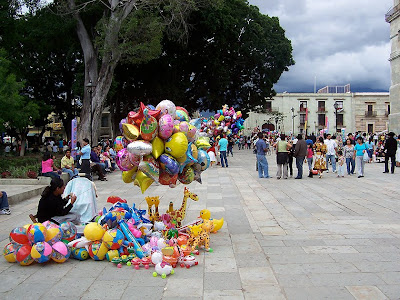Our time in Oaxaca was blessed by a really nice hostel we found by accident after all the ones we tried to book on the internet had no doubles available. In the middle of looking for another hostel I noticed el Quijote had rooms free and had nice facilities and was no more expensive than the other fairly pricey hostels at $400 P for a double.
 Interior scenes - note the nifty five bladed fan, which was almost inaudible on the first setting
Interior scenes - note the nifty five bladed fan, which was almost inaudible on the first settingIt proved to be another Shangri-la experience, seemingly empty apart from ourselves who were given a private bathroom on the ground floor at shared bathroom rates because they worried I would fall down the stairs. This formed the base for a series of adventures to the historic centre with its running playground of performers, further north to the richly decorated, Santo Doningo church, out to the Zapotec mountain centre o fMonte Alban with its rich artifacts, and to the markets to buy our meals to cook in the hostel kitchen.
 A church on the way to the zocalo
A church on the way to the zocaloFinding a supermarket to buy food finally proved absolutely impossible in central Oaxaca as the mere mention of the word supermercado caused everyone to send you to the labyrinthine city markets, which we ended up depending on once we knew where to get each thing we needed from bread and milk through butter and cheese to vegetables, fruit, and eggs (no we couldn't face the apparently fresh beef lying on benches in the totally unrefrigerated dense market atmosphere.
 Its decorated ceiling and walls
Its decorated ceiling and wallsI have taken a lot of street images because Oaxaca has very fine buildings very nicely restored to colonial splendour and have otherwise concentrated on street performers, a few key churches and their interiors and a good taste of the markets because they really became a centre of our life for the two nights we stayed there.
 A block closer to the zocalo
A block closer to the zocaloWe also made a calculated pilgrimage quatro quadras, or four blocks, north to the local HSBC to try to get our peso cash advance for no surcharge, only to find that although HSBC NZ had guaranteed they would impose no charges for cash withdrawals, the HSBC Mexico did, albeit just 22 peso, around $2, and around half the 45 peso surcharge other banks did for foreign cards, although other Mexican banks don't charge for their own cards.
 Roasted sweet corn on sale from braziers in the street
Roasted sweet corn on sale from braziers in the streetIncidentally the word 'zocalo' which now spells the central park and plaza in just about every Mexican city actually means 'base' (yes just like al Qaeda does) and seems to have come from an attempt in the 19th century to erect a statue in the Mexico Ciudad central plaza which never eventuated leaving only the base completed. Another Mexican irony.
Okay here goes the rest of the photo shoot ....
Okay here goes the rest of the photo shoot ....







Mass grande balloons on sale
 The facade and interior is crowned by the symbol of the dove
The facade and interior is crowned by the symbol of the doveand a bunch of popes, as in St. Peters Rome






 Fruit stalls outside, and a meat shop inside whose carne we couldn't face.
Fruit stalls outside, and a meat shop inside whose carne we couldn't face. Three famous Oaxacan festivals, the Day of the Dead, the Guelaguetza and the Night of the Radishes.
Three famous Oaxacan festivals, the Day of the Dead, the Guelaguetza and the Night of the Radishes.In the brief time we were in Oaxaca we had no opportunity to see any of the famous annual festivals but above for the record are the three most prominent, the Day of the Dead Nov 2 when dancing parties are held in the cemetery, the Guelaguetza festival of folk dance on the first two Mondays after July 16th and the Night of the Radishes, when carved giant radishes are displayed around the Zocalo.

























No comments:
Post a Comment